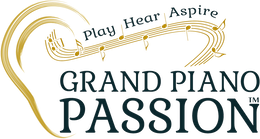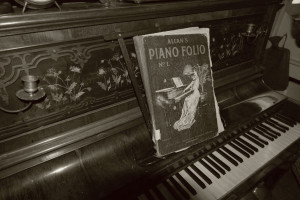The initial idea was to make a short film. A nice little film crammed with beauty shots of the internal organs of a piano. I reckoned it would take about four days to shoot.
Then I set foot in Richard Davenport’s Los Angeles piano workshop and saw the gleaming rows of chisels and complex measuring devices. It was apparent right away that Richard and his band of “Merry Workers,” with their frightening skills and hilarious repartee, demanded deeper treatment.
We ended up filming American Grand over a nine-month period, shooting once or twice a week. The resulting documentary aired on PBS TV in prime time.
I’m a pretty serious amateur pianist. I practice two hours a day and have been playing for (gulp) 60 years. For the last 25 years, I have owned a nine-foot Yamaha CFIII concert grand. Both in size and upkeep, this is a bit like fostering a hippopotamus. Richard, a high-octane Los Angeles piano technician, looks after this monster for me. He’s rebuilt it once and, a few years later, he restrung it. So, in my arrogance, I reckoned that I knew a helluva lot about pianos.
I could not have been more wrong.
Even after nine months of shooting and a year of editing, I still don’t really understand how the Cristofori escapement works, but I do know how to spell his name. On the other hand, I’ve learned how a piano can sound completely different after a top technician has really had a go at it. I’ve seen that a new soundboard is a heart transplant for a piano. I’ve heard how the feel and touch of the instrument can be radically altered by the key-dip and by other weirdly named stuff like “let-off” and “damper assist springs.”
But now I’m showing off. Nevertheless, I’ll bet that, after making this film, I know more about the piano’s brain than 99 percent of professional pianists. Digging around inside the piano action and learning how all those tiny components affect the tone has taught me a lot about simply listening to the instrument—how to hear and feel when something is out of whack. And that has helped me to play a little better. Minimally, my playing went from awful to passable. But, hey, that’s a step in the right direction.
The piano restoration job we filmed was the complete rebuild, from soup to nuts, of a 1913 American Steinway. This involved removing its entire digestive tract and replacing everything with new parts. Pinblock, strings, keys, wippens, hammers, shanks, dampers—all were pulled out—and, climactically, with considerable brute force, the old soundboard was torn out. After the disassembly, there remained just a shell consisting of the outer wood rim, the big metal plate, and the legs.
I was terrified. Are these people insane? How are they going to put it back together? But, over the ensuing months, while we filmed, the new parts would arrive and were fitted. My panic receded. Now, when I say “fitted,” that sounds as if these parts were just sorta slotted into predetermined positions, right? Nope. Installation often involves tolerances of a ten-thousandth of an inch. It’s like building an atomic bomb.
When the first stage of rebuilding was completed, Richard invited several of his really brilliant pianist clients to try it out. So that was a bit scary—at least for me. At first, the piano sounded very harsh. Richard said it “couldn’t sound more bright.” But, during the breaks between guest pianists, tiny adjustments were made, voodoo occurred … and the tone gradually improved.
I reckon that anyone who cares about piano playing should seek out a place like Richard’s and spend a day—or even a couple of hours—with the technicians, just chatting and asking questions. However, if you are curious but lazy, like me, you could watch my film, which condenses a year of restoration work into 82 minutes.
I’m sure that you, the reader who has bothered to get thus far, love pianos. And I guarantee that, after such a visit, or after viewing American Grand, you will emerge a better player.
You can access the film to stream at https://streamingmoviesright.com/us/movie/american-grand.




Iwant to buy the dvd of “American Grand” Please tell me how to get it.
Steven, I’m not sure if the DVD is available anymore, but you can watch the film online here: https://www.amazon.com/American-Grand-Richard-Davenport/dp/B00IQ44K7G